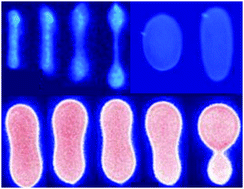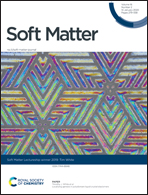Conformational dynamics and phase behavior of lipid vesicles in a precisely controlled extensional flow†
Abstract
Lipid vesicles play a key role in fundamental biological processes. Despite recent progress, we lack a complete understanding of the non-equilibrium dynamics of vesicles due to challenges associated with long-time observation of shape fluctuations in strong flows. In this work, we present a flow-phase diagram for vesicle shape and conformational transitions in planar extensional flow using a Stokes trap, which enables control over the center-of-mass position of single or multiple vesicles in precisely defined flows [A. Shenoy, C. V. Rao and C. M. Schroeder, Proc. Natl. Acad. Sci. U. S. A., 2016, 113(15), 3976–3981]. In this way, we directly observe the non-equilibrium conformations of lipid vesicles as a function of reduced volume ν, capillary number Ca, and viscosity contrast λ. Our results show that vesicle dynamics in extensional flow are characterized by the emergence of three distinct shape transitions, including a tubular to symmetric dumbbell transition, a spheroid to asymmetric dumbbell transition, and quasi-spherical to ellipsoid transition. The experimental phase diagram is in good agreement with recent predictions from simulations [V. Narsimhan, A. P. Spann and E. S. Shaqfeh, J. Fluid Mech., 2014, 750, 144]. We further show that the phase boundary of vesicle shape transitions is independent of the viscosity contrast. Taken together, our results demonstrate the utility of the Stokes trap for the precise quantification of vesicle stretching dynamics in precisely defined flows.

- This article is part of the themed collection: Soft Matter Most Popular 2020


 Please wait while we load your content...
Please wait while we load your content...